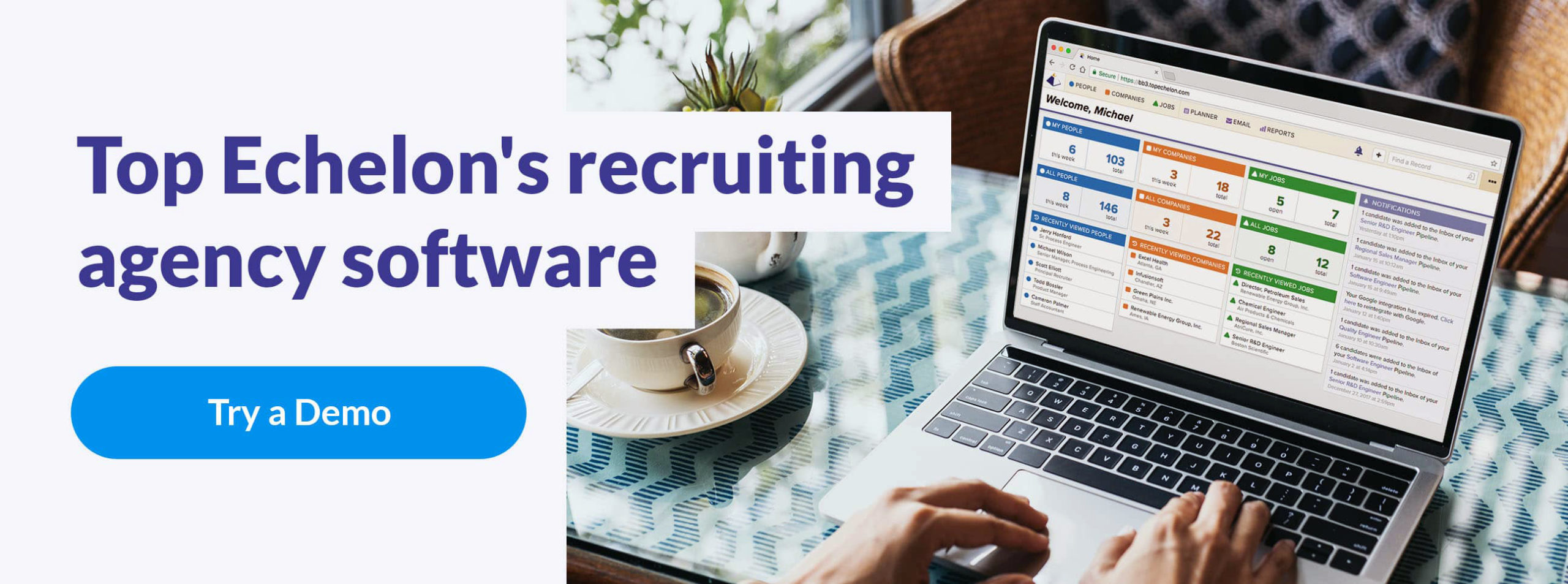At first glance, conducting an interview seems straightforward. You shake hands, ask questions, and choose the best candidate when you’re done. But if you want to hire top talent, you need an effective interview structure.
How to structure an interview
Chances are, winging it won’t help you find the candidate your client wants. Create an interview structure before meeting with candidates. Get ready ahead of time so you can easily navigate the interview. Use the following structured interview format as a guide.
1. Introductions
The structure of your interview should start with introducing yourself to the candidate. Tell them your name and involvement in the hiring process. Also, have the client give their name, title, and a brief introduction.
Before diving into interview questions, prepare the candidate for the meeting. Give a short explanation of how the process will go and how long it should take.
Recruiter Tip: Pay attention to the candidate’s body language during the introduction. Do they shake your hand and maintain eye contact? Check to see if they look calm and confident.
2. Profile
Lead the conversation by learning more about the candidate. Make sure you have the candidate’s resume in front of you. Let the candidate present him/herself and talk about their experiences.
During the conversation, ask questions related to the resume to fill in the gaps. For example, you might ask for specific dates or what kind of company they worked for.
Recruiter Tip: Give each interviewer a copy of the candidate’s resume. As the candidate speaks, take notes directly on the resume. This will help you keep information organized and compare impressions after the interview. You can also use an interview scorecard to compare candidate answers.
3. Motivations
After you learn the candidate’s story, you should understand the candidate’s values and interest level. This part of the interview helps you find out the “why” behind their application.
There are several motivations you can ask the candidate about. Learn why the candidate applied for the job and why they want to work for your client. Have them list the tasks they enjoy/dislike at their current position. Also, ask them to describe why they are a good fit for the job. You may even take this a step further by giving the candidate a job fit test.
Recruiter Tip: Pay attention to the candidate’s motives behind why they want the job in this stage of the interview structure. See how well they prepared for this question and if they express enthusiasm. The more motivated the candidate, the less likely they are to quit soon after being hired.
4. Skills
You need to be sure the candidate can succeed at the client’s company. Have the candidate describe how their expertise matches the job requirements.
Ask situational questions about the candidate’s current and past jobs. For example, you might say, “Tell me about a time you had to solve a problem at work.” Listen to how the candidate handled these challenges.
Recruiter Tip: Keep an eye out for additional skills that are not specified on your client’s list but add value. For example, if you’re hiring a designer that will work with others, find out if the candidate has been involved in a team. Adding this to the structure of an interview could help with your client’s final hiring decision.
5. Cultural fit
For a placement to be successful, the candidate must fit in with the client’s company. Check that the candidate’s values align with the client’s mission. For example, find out if the candidate prefers a casual work culture to a formal environment.
Ask behavioral interview questions that reveal the candidate’s personal and social skills. Some details might include teamwork, ability to work under pressure, and creative initiative. Compare their answers to your client’s ideal candidate.
Recruiter Tip: Leave personal opinions out of the equation. You don’t want to be accused of discrimination during the recruitment interview process. Truly look for the candidate that matches the client’s values.
6. Client’s business and job description
The candidate is not the only person in the room trying to impress. You need to make the position look enticing for applicants to accept an offer.
Give details about the client’s company. Talk about the work environment, how the company is organized, and what it does. Describe the tasks involved in the position, common challenges, training, and advancement opportunities.
Recruiter Tip: Ask the candidate what they know about the client’s company before going into detail. You can see if they did their research before the interview.
7. Salary
If the candidate’s salary expectations don’t match what your client is willing to offer, there won’t be a placement. In fact, recent recruiting trends indicate that one of the top three reasons for a candidate turning down a job offer is a low salary. Save the end of the interview to talk about the compensation package.
Before the interview, know average salaries, how experience affects salary, and what your client will pay. During the meeting, ask the candidate their expected salary range. Tell them the salary range as well as any benefits or perks.
Recruiter Tip: Discuss compensation packages with your client in depth before the interview. There should be no confusion about what is being offered. Make sure your client is providing a competitive salary that fits into their budget.
8. Questions
Open the conversation up to questions. Let the candidate ask questions and clarify issues that might have come up. And, make sure you have all the information you need to move on in the hiring process.
Recruiter Tip: Give the candidate your contact information and let them know they can contact you with questions. Encouraging a dialogue helps you make a better placement.
9. Conclusion
Discuss the next steps in an effective interview process. Let the candidate know when you will contact them, what happens next, and if you need additional resources. Make sure all parties exchange the correct contact information.
Thank the candidate for meeting with you and your client. Even if the client is not selected for the position, you need to maintain a structured interview process to provide a positive candidate experience. Keep the disqualified applicant in your candidate pool for future jobs.
Recruiter Tip: Use an applicant tracking system (ATS) or recruiting software to keep track of candidate information. You can import notes from interviews and organize them in the software. This makes it easy to revisit candidate for new clients and jobs.









